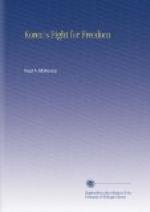“The above I saw myself and testify to the truthfulness of my statements. In all my contact with the Koreans these five days, and in all my observation of the crowds inside and outside the city, I have witnessed no act of violence on the part of any Korean.”
The Theological Seminary was due to open on March 5th. Five students from South Korea arrived and went into their dormitory on the afternoon of the 4th. They had taken no part in the demonstrations. Later in the afternoon the soldiers, searching after some people who had run away from them, burst into the seminary. They broke open the door of the dormitory, pulled the five theologues out and hauled them off to the police station. There, despite their protests, they were tied by their arms and legs to large wooden crosses, face downwards, and beaten on the naked buttocks, twenty-nine tremendous blows from a hard cane, each. Then they were dismissed.
That same night firemen were let loose on the village where many of the students lived and boarded. They dragged out the young men and beat them. The opening of the seminary had to be postponed.
The Japanese were eager to find grounds for convicting the missionaries of participation in the movement. One question was pressed on every prisoner, usually by beating and burning, “Who instigated you? Was it the foreigners?”
Dr. Moffett was a special object of Japanese hatred. The Osaka Asahi printed a bitter attack on him on March 17th. This is the more notable because the Asahi is a noted organ of Japanese Liberalism.
THE EVIL VILLAGE OUTSIDE THE WEST GATE IN PYENG-YANG
A Clever Crowd
“Outside the West Gate in Pyeng-yang there are some brick houses and some built after the Korean style, some high and some low. These are the homes of the foreigners. There are about a hundred of them in all, and they are Christian missionaries. In the balmy spring, strains of music can be heard from there. Outwardly they manifest love and mercy, but if their minds are fully investigated, they will be found to be filled with intrigue and greed. They pretend to be here for preaching, but they are secretly stirring up political disturbances, and foolishly keep passing on the vain talk of the Koreans, and thereby help to foster trouble. These are really the homes of devils.
“The head of the crowd is Moffett. The Christians of the place obey him as they would Jesus Himself. In the 29th year of Meiji freedom was given to any one to believe in any religion he wished, and at that time Moffett came to teach the Christian religion. He has been in Pyeng-yang for thirty years, and has brought up a great deal of land. He is really the founder of the foreign community. In this community, because of his efforts there have been established schools from the primary grade to a college and a hospital. While they are educating the Korean children and healing their diseases on the one hand, on the other there is concealed a clever shadow, and even the Koreans themselves talk of this.
“This is the centre
of the present uprising. It is not in Seoul
but in Pyeng-yang.




